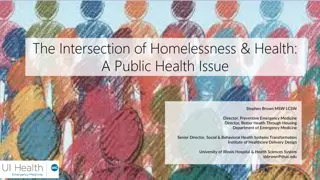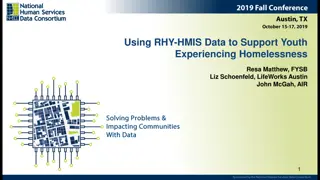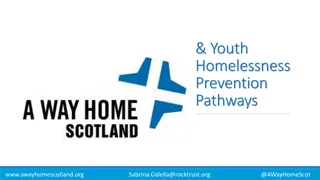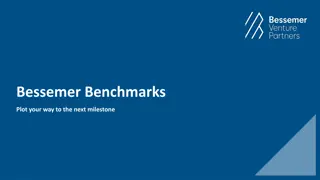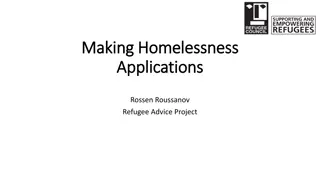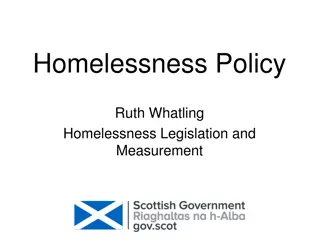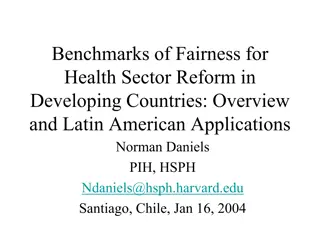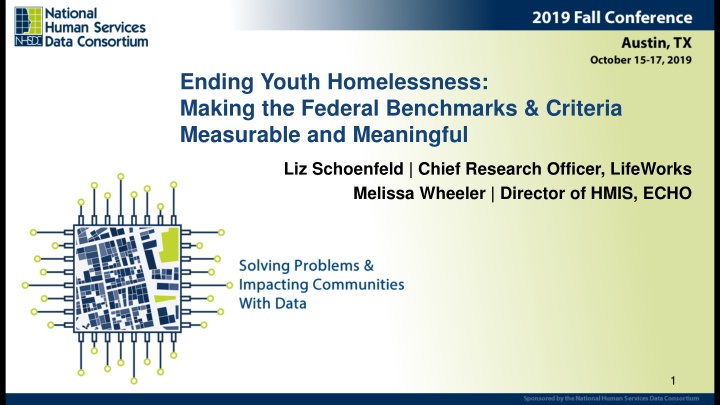
Enhancing Youth Homelessness Solutions through Federal Benchmarks & Criteria
Learn about the federal benchmarks and criteria guiding communities in ending youth homelessness. Explore the key elements of a community response, qualitative criteria, and quantitative benchmarks to assess system effectiveness.
Download Presentation

Please find below an Image/Link to download the presentation.
The content on the website is provided AS IS for your information and personal use only. It may not be sold, licensed, or shared on other websites without obtaining consent from the author. If you encounter any issues during the download, it is possible that the publisher has removed the file from their server.
You are allowed to download the files provided on this website for personal or commercial use, subject to the condition that they are used lawfully. All files are the property of their respective owners.
The content on the website is provided AS IS for your information and personal use only. It may not be sold, licensed, or shared on other websites without obtaining consent from the author.
E N D
Presentation Transcript
Ending Youth Homelessness: Making the Federal Benchmarks & Criteria Measurable and Meaningful Liz Schoenfeld | Chief Research Officer, LifeWorks Melissa Wheeler | Director of HMIS, ECHO 1
A Little Context The goal of the Youth Homelessness Demonstration Program is to effectively prevent and end youth homelessness by 2020 Youth are defined as any individual under the age of 25 who is unaccompanied by a parent/guardian and who meets any federal definition of homelessness The first 10 YHDP communities were selected in January 2017 To date, 44 communities have been funded 2
What are the Federal Benchmarks & Criteria? The goal of the federal benchmarks and criteria is to help guide YHDP communities toward developing a coordinated community response to end youth homelessness Criteria are more qualitative in nature Describe the key elements of a community s response Benchmarks are more quantitative in nature Assess whether and how the system is working 3
Criteria The community identifies all unaccompanied youth experiencing homelessness. The community uses prevention and diversion tactics whenever possible, and otherwise provides immediate access to low-barrier crisis housing and services to any youth who needs and wants it. The community uses coordinated entry processes to effectively link all youth experiencing homelessness to housing and service solutions that are tailored to their needs. The community acts with urgency to swiftly assist youth to move in to permanent or non-time-limited housing options with appropriate services and supports. The community has resources, plans, and system capacity in place to continue to prevent and quickly end future experiences of homelessness among youth. 4
Benchmarks There are few youth experiencing homelessness at any given time. - The community s census of youth experiencing homelessness includes all unaccompanied youth under 25 that meet any federal definition of homelessness. - No unaccompanied youth are experiencing unsheltered homelessness. - No unaccompanied youth seeking emergency shelter are turned away unless they can be successfully diverted to another safe living environment of their choosing. 5
Benchmarks There are few youth experiencing homelessness at any given time (cont d). - All youth identified as experiencing homelessness are offered connections to appropriate services on an ongoing basis to support sustainable exits from homelessness. - The number of unaccompanied youth currently experiencing sheltered homelessness demonstrates the community s capacity to address emerging needs through exits to permanent or non-time-limited safe and stable housing destinations, including reunification. - The community s census of unaccompanied youth experiencing homelessness is not increasing over time. 6
Benchmarks Youth experiencing homelessness are swiftly connected to safe and stable housing opportunities and to permanent housing options. - Unaccompanied youth identified as experiencing unsheltered or sheltered homelessness (including emergency shelter or basic center programs) exit to permanent or non-time-limited safe and stable housing within a community-wide average of 30 days, and no longer than 90 days from the point of identification. 7
Our Experiences to Date Began considering how to operationalize the YHPD benchmarks in February 2017 Regular participation in monthly community calls One of 12 communities to participate in USICH/Abt Associates pilot project of the benchmarks & criteria Had the opportunity to provide feedback and recommendations to USICH based on our experiences 8
What We Learned: Be Strategic with your Community Plan All YHDP communities are required to develop a coordinated community plan outlining their systemic approach to prevent and end youth homelessness Use USICH s criteria to structure your coordinated community plan - Keeps the focus on what is required - Allows for purposeful action planning 9
What We Learned: Greater Need for Cross-System Collaboration All YHDP communities are required to develop a coordinated community plan outlining their systemic approach to prevent and end youth homelessness Use USICH s criteria to structure your coordinated community plan - Keeps the focus on what is required - Allows for purposeful action planning 10
What We Learned: Greater Need for Cross-System Collaboration Key partners include local school districts, child welfare, and juvenile justice Progress to date has been largely relationship-based These systems have no broader incentive or mandate to collaborate on the project Accessing data from these systems remains illusive 11
What We Learned: HMIS is Key There was no expectation that the benchmarks be measured using existing HMIS data elements Made the executive decision to rely on existing HMIS data elements and create our own tool Identified some proxy variables: Number of youth that requested shelter Treating the census as the number of youth who are requesting shelter Number of youth with first offer of permanent housing more than 30 days from identification Strictly using move-in date (not the date that the offer is accepted ) 12
What We Learned: HMIS is Key Some of the benchmarks would require tracking data elements that would be fairly burdensome to collect: Number of youth receiving connections to appropriate service during the lookback period Number of youth who refused an offer of emergency shelter Number of youth with first offer of permanent housing more than 30 days from identification Consistently tracking such data community-wide would require a federal mandate Highlighted a need for broader standardization (e.g., timing of program dismissals) 13
What We Learned: HMIS is Key Benefits of using HMIS to monitor progress toward the benchmarks: Incentivize (consistent!) data collection Allows for centralized data storage Reduces the cost to communities Increases transparency Supports cross-community learning Supports the certification process 14
What We Learned: Expanded Definition of Homelessness = More Resources YHPD communities are expected to prevent and end homelessness for youth experiencing any federal definition of homelessness Additional funding and resources need to be allocated to Coordinated Entry teams to support communities ability to meet this expectation 15
Questions? Liz Schoenfeld, PhD Chief Research Officer | LifeWorks liz.Schoenfeld@lifeworksaustin.org Melissa Wheeler, MSW Director of HMIS | ECHO melissawheeler@austinecho.org 16



